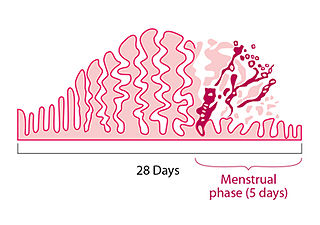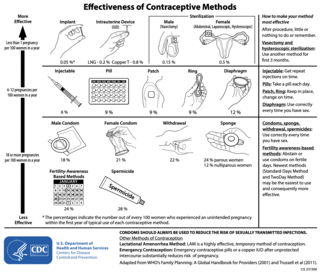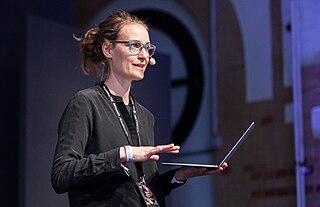
Fertility awareness (FA) refers to a set of practices used to determine the fertile and infertile phases of a woman's menstrual cycle. Fertility awareness methods may be used to avoid pregnancy, to achieve pregnancy, or as a way to monitor gynecological health.

The combined oral contraceptive pill (COCP), often referred to as the birth control pill or colloquially as "the pill", is a type of birth control that is designed to be taken orally by women. It is the oral form of combined hormonal contraception. The pill contains two important hormones: a progestin and estrogen. When taken correctly, it alters the menstrual cycle to eliminate ovulation and prevent pregnancy.
Calendar-based methods are various methods of estimating a woman's likelihood of fertility, based on a record of the length of previous menstrual cycles. Various methods are known as the Knaus–Ogino method and the rhythm method. The standard days method is also considered a calendar-based method, because when using it, a woman tracks the days of her menstrual cycle without observing her physical fertility signs. The standard days method is based on a fixed formula taking into consideration the timing of ovulation, the functional life of the sperm and the ovum, and the resulting likelihood of pregnancy on particular days of the menstrual cycle. These methods may be used to achieve pregnancy by timing unprotected intercourse for days identified as fertile, or to avoid pregnancy by avoiding unprotected intercourse during fertile days.

Menstruation is the regular discharge of blood and mucosal tissue from the inner lining of the uterus through the vagina. The menstrual cycle is characterized by the rise and fall of hormones. Menstruation is triggered by falling progesterone levels and is a sign that pregnancy has not occurred.

Ovulation is the release of eggs from the ovaries. In women, this event occurs when the ovarian follicles rupture and release the secondary oocyte ovarian cells. After ovulation, during the luteal phase, the egg will be available to be fertilized by sperm. In addition, the uterine lining (endometrium) is thickened to be able to receive a fertilized egg. If no conception occurs, the uterine lining as well as the egg will be shed during menstruation.

A hormonal intrauterine device (IUD), also known as an intrauterine system (IUS) with progestogen and sold under the brand name Mirena among others, is an intrauterine device that releases a progestogenic hormonal agent such as levonorgestrel into the uterus. It is used for birth control, heavy menstrual periods, and to prevent excessive build of the lining of the uterus in those on estrogen replacement therapy. It is one of the most effective forms of birth control with a one-year failure rate around 0.2%. The device is placed in the uterus and lasts three to eight years. Fertility often returns quickly following removal.

There are many cultural aspects surrounding how societies view menstruation. Different cultures view menstruation in different ways. The basis of many conduct norms and communication about menstruation in western industrial societies is the belief that menstruation should remain hidden. By contrast, in some hunter-gatherer societies, menstrual observances are viewed in a positive light, without any connotation of uncleanness.

″
Pregnancy rate is the success rate for getting pregnant. It is the percentage of all attempts that leads to pregnancy, with attempts generally referring to menstrual cycles where insemination or any artificial equivalent is used, which may be simple artificial insemination (AI) or AI with additional in vitro fertilization (IVF).

CycleBeads is a visual tool that was developed by the Institute for Reproductive Health at Georgetown University. This device helps women use the Standard Days Method, a fertility awareness-based family planning method.

An activity tracker involves the practice of measuring and collecting data on an individual's physical and psychological activity to keep track and maintain documentation regarding their health and wellness. Used for many groups even animals as seen in collar-mounted activity trackers for dogs. A lot of the data is collected through wearable technology such as wristbands which sync with mobile apps through Apple and Samsung. As daily technologies such as phones and computers have been innovated, it paved the way for such wearable tracking technologies to be advanced. There are a variety of stakeholders involved in the usage of activity tracking through wearable technology and mobile health apps, knowing how much they track ranging from fitness, mood, sleep, water intake, medicine usage, sexual activity, menstruation, and potential diseases raises the concern on privacy given a lot of data is collected and analyzed. Through many studies that have been reviewed, data on the various demographics and goals these technologies are used provide more insight into their purposes.

Health is a health informatics mobile app, announced by Apple Inc. on June 2, 2014, at its Worldwide Developers Conference (WWDC). The app is available on iPhone and iPod Touch devices running iOS 8 or later, and on iPads running iPadOS 17 or later. The application holds health data such as blood pressure measurement and glucose levels, but also holds physical tracking data such as step counts. It can pull data from fitness trackers, smartwatches, smart scales, and other devices.
Clue is a menstrual health app developed by the Berlin-based technology company BioWink GmbH. The app has over 15 million users from 180 different countries. The startup has raised over $17 million from backers that include Union Square Ventures and Mosaic Ventures.

Ida Tin is a Danish internet entrepreneur and author who is the co-founder and CEO of the women's menstruation-tracking app, Clue. She is credited with coining the term "femtech".
Kindara is a femtech company headquartered in Colorado that develops apps that help women identify their fertile window. The products are used for women trying to get pregnant, or women who want to track their menstrual cycle for overall health. Their latest product, Priya Fertility and Ovulation Monitor, maximizes a woman's chance of getting pregnancy by identifying her most fertile days.
Natural Cycles is a mobile app designed to help women track their fertility. The app predicts the days on which a woman is fertile and may be used for planning pregnancy and contraception. It was developed by scientist Elina Berglund, who founded the company with her husband, Raoul Scherwitzl.
Bellabeat is a wellness company founded by Urška Sršen and Sandro Mur in 2014. It is best known for its Leaf smart jewelry wearable line. The company has offices in San Francisco, Zagreb and Hong Kong.
Flo is a health app that provides menstruation tracking, cycle prediction, and information regarding preparation for conception, pregnancy, early motherhood, and menopause.
Ava is a medical technology company that developed the Ava bracelet, a wearable device that functions as a fertility tracker.
Menstrual suppression refers to the practice of using hormonal management to stop or reduce menstrual bleeding. In contrast to surgical options for this purpose, such as hysterectomy or endometrial ablation, hormonal methods to manipulate menstruation are reversible.











